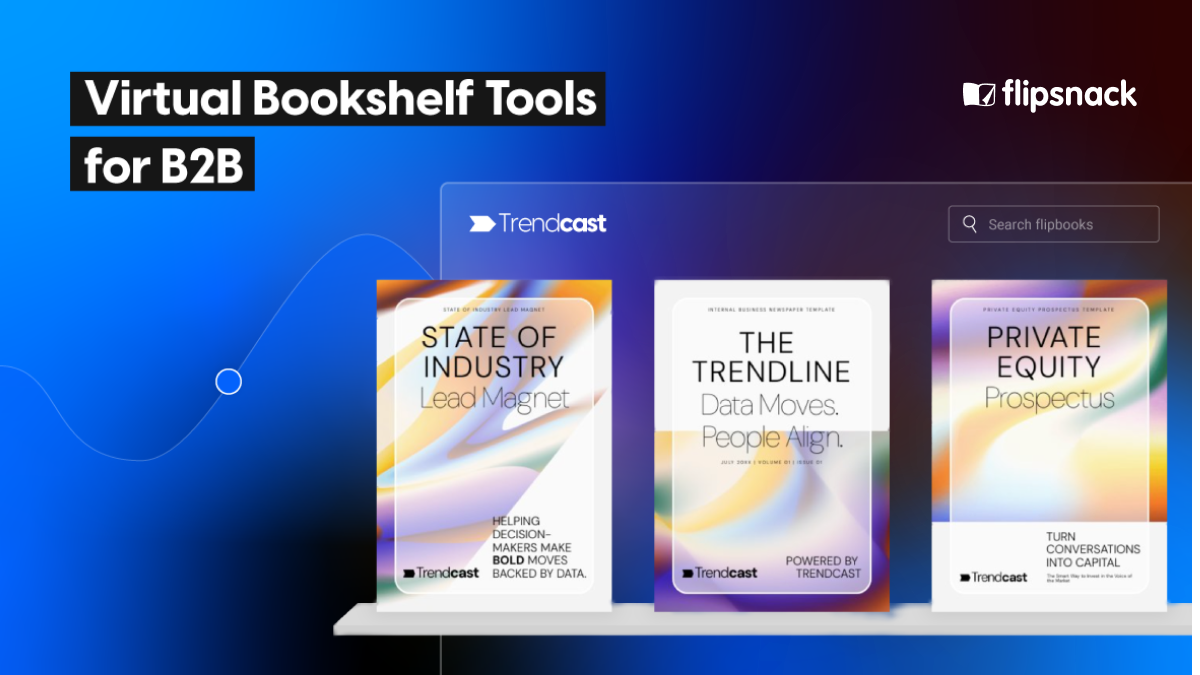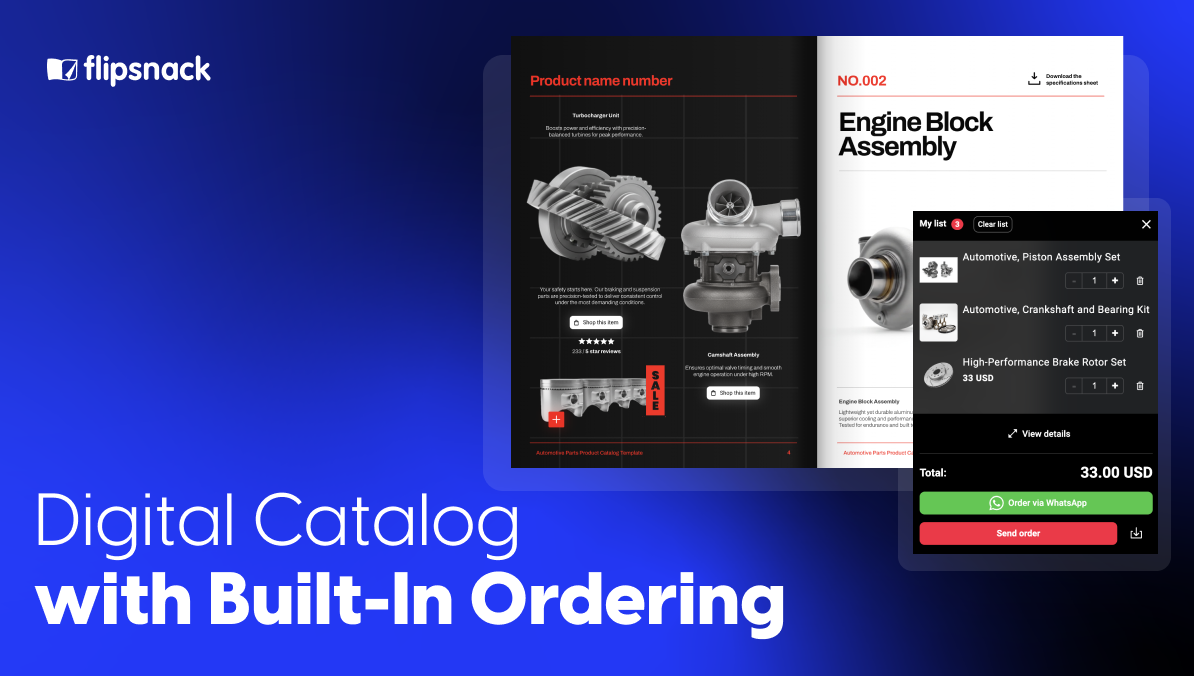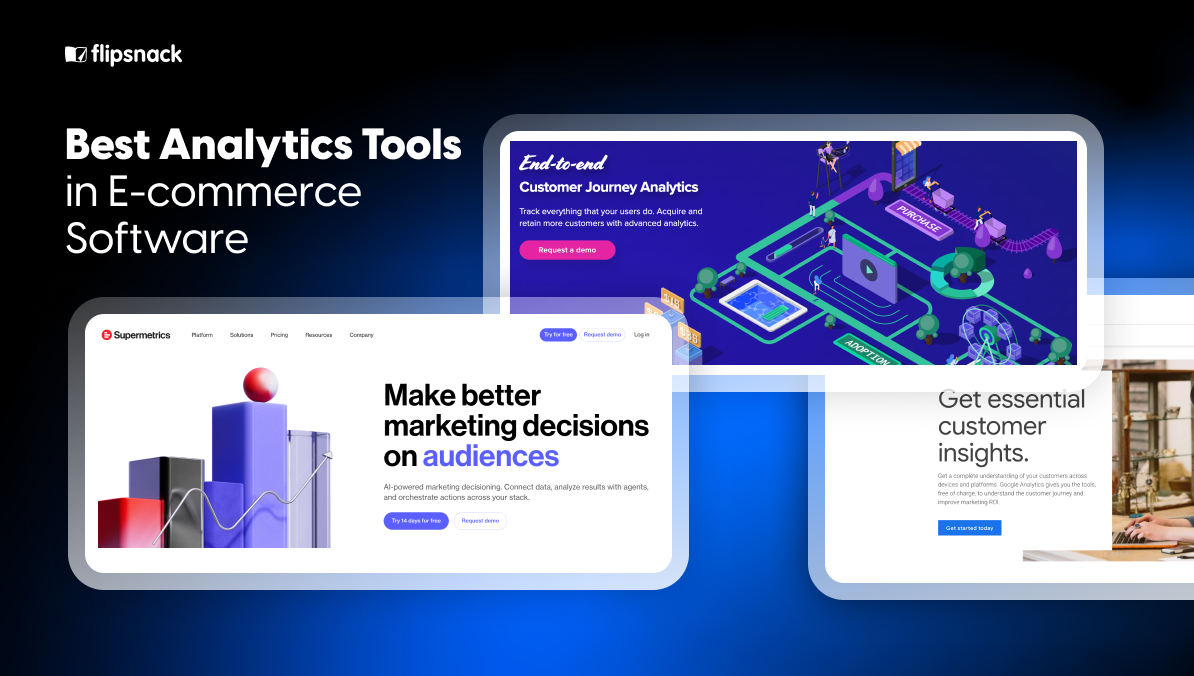Virtual Bookshelf Tools for B2B in 2025: 10+ Software Compared
In the B2B world, companies often have numerous digital publications, from product catalogs and sales brochures to training manuals and corporate magazines. A virtual bookshelf is a feature that allows you to organize and display all these flipbooks in one central, branded hub. Instead of sending out individual PDF links or files, a virtual bookshelf lets your audience access a whole collection under a single link or embed.
This is especially valuable for businesses: sales teams can always pull up the latest catalog (even via a QR code scan), HR/training departments can securely share updated manuals, and marketing teams can track content performance across an entire shelf of materials.
Below, we rank the top virtual bookshelf tools available for flipbook platforms, with a focus on how they handle organization, embedding, branding, search, analytics, and secure access for B2B needs.
What is a virtual bookshelf?
A virtual bookshelf is a branded, web-based library that displays multiple publications (flipbooks) behind a single link or embed. Readers can browse, search, and open items without leaving the page; admins can update the shelf without changing the URL, and track performance across the entire collection. In Flipsnack, for example, you can add/remove flipbooks while keeping the same shelf link. You can also enable shelf search.
Why businesses use virtual bookshelves:
- One link for many assets (no more sending multiple URLs)
- Embeddable on websites, portals, and intranets
- Private or public access with granular security
- Shelf‑level and item‑level analytics
- Faster content ops: update once, everywhere

What is a virtual bookshelf feature in a flipbook platform?
It’s the native module that lets you group, brand, secure, embed, and analyze a set of flipbooks, no custom code required. Most platforms call it Bookshelf, Bookcase, Collection, Library Widget, or Kiosk.
Typical controls include layout customization, branding, domain-restricted embeds, password/SSO access, search, analytics, and accessibility features. And this solution improves client proposals and marketing asset management.
What should you look for in a virtual bookshelf tool?
For B2B teams, choosing a virtual bookshelf goes beyond just grouping flipbooks together. You need a tool that supports distribution, security, analytics, branding, accessibility, and scalability, all in one place. Here are the key areas to evaluate:
1. Distribution & Embed
Your bookshelf should make sharing and embedding easier while ensuring compatibility across environments.
- Embed flexibility: Generate copy-paste embed codes that work on any CMS, intranet, or portal.
- Responsive design: Ensure shelves display properly on desktop, tablet, and mobile.
- Domain restrictions: Control where shelves render, limiting embeds to approved websites or portals.
- Omnichannel distribution: Support sharing through email snippets, direct links, QR codes, and social channels.
2. Access & Security
Enterprises often deal with sensitive training materials, partner resources, or internal documentation. Secure sharing plays an important role:
- Access levels: Public, unlisted, password-protected, or invitation-only.
- Enterprise authentication: SSO options via Okta, Azure AD/Entra, or Google so employees/partners use their existing accounts.
- Embed security: Protected embeds that lock shelves to a specific site or environment.
- Granular permissions: Ability to manage access at the shelf or individual publication level.
3. Findability & UX
Readers need to locate content quickly, while teams should ensure accessibility for all users.
- Shelf-level search: Let users search across publications, not just within titles.
- Sorting & filters: Organize by date, type, or custom categories.
- Accessibility: Keyboard navigation, screen-reader support, and alt text options to comply with accessibility standards.
- User-friendly design: Hover titles, customizable thumbnails, and open-in-new-tab options improve the browsing experience.
4. Analytics
Measuring content performance at both the shelf and publication level is crucial for a B2B strategy.
- Shelf-level metrics: Track impressions, views, unique visitors, average time spent, device types, and traffic sources.
- Flipbook-level: See engagement per publication inside the shelf.
- Integrations: Connect with Google Analytics 4 or other tools for advanced reporting.
- Exportable reports: Download data for internal presentations or audits.
5. Branding
A bookshelf should look and feel like a natural extension of your company’s brand.
- Brand customization: Add logos, adjust layouts, and apply custom color palettes.
- Custom domains/subdomains: Publish shelves under your brand’s domain (e.g., training.yourcompany.com).
- White-label options: Remove platform branding for a seamless corporate experience.
- Email & QR: Ensure outbound communications (emails, QR codes) carry your visual identity.
6. Operations
As your content library grows, operations should remain simple and efficient.
- One shelf, many updates: Keep a single URL while adding/removing flipbooks as needed.
- Bulk management: Rearrange, update, or replace multiple flipbooks quickly.
- Cross-channel sharing: Distribute once and repurpose via links, email, intranet, or print-to-digital (QR codes).
- Scalability: Ensure the tool can handle multiple shelves, departments, and regions without slowing down.
How to centralize digital publications: Best virtual bookshelf software/platforms
1. Flipsnack
Flipsnack’s Bookshelf is built for B2B distribution: shelf search, domain-restricted embeds, branded layouts, QR codes, email snippets, and shelf analytics (impressions, views, time, device, source). There’s also SSO for viewers, so employees/partners authenticate with your IdP without separate accounts. Accessibility encompasses keyboard navigation and screen reader support.
Notable bookshelf & branding features
- Enable search within the bookshelf; set open-in-new-tab, hover titles, thumbnail sizing
- Embed with domain restrictions; customizable branding with background, logo, and color palette
- Use a custom domain or subdomain and remove Flipsnack branding to make the bookshelf look like part of your own site
- Statistics at the shelf and flipbook level (summary + breakdown)
- SSO options (Azure AD/Entra, Okta, Google; SSO for viewers)
Best for:
- Enterprises needing secure internal/partner libraries (HR, L&D, Sales, Marketing)
- Global brands with multi‑market catalogs and private training hubs
- Example of customers that succeed with Flipsnack: Electrolux, Estée Lauder, Pandora
How Estée Lauder Centralized Internal Training with a Flipsnack Bookshelf
At Estée Lauder, the U.S. Education Team needed a simpler way to deliver seasonal training resources to their 60,000+ field employees.
Instead of relying on SharePoint folders, they built with Flipsnack a bookshelf that is a hub that groups all training flipbooks under a single link. Field teams could bookmark it on their devices and access organized chapters, links, GIFs, videos, and images anytime, anywhere.
This bookshelf turned scattered files into a centralized digital library, making on-the-spot learning easier, more engaging, and far more efficient. As a result, employee knowledge and engagement rose significantly, proving the value of Flipsnack as a training and communication tool.
2. FlippingBook
FlippingBook’s Collections/Bookcase lets readers search titles in the shelf toolbar, and you can apply passwords or protected embed to restrict viewing to your site. Shelf search is title-only, not content. Analytics are per flipbook only (no shelf-level dashboard). Branding and access controls are more basic (no SSO for viewers).
Best for: Simpler collections for marketing and sales collateral.
3. Publuu
Publuu supports a branded Virtual Bookshelf you can customize and embed, plus Google Analytics 4 integration for deeper tracking (views, audience). Doesn’t offer shelf-specific analytics within the platform. Access/security controls are lighter (no domain restrictions, no SSO).
Best for: SMBs and publishers wanting a quick shelf + GA4 measurement.
4. FlipHTML5
FlipHTML5 lets you embed a Bookcase (their term for a virtual bookshelf) to showcase multiple flipbooks on your site, no coding beyond paste‑in embed. Branding and analytics are minimal, and shelf search is basic.
Best for: Simple public libraries where easy embedding matters most.
5. Joomag
Joomag supports embedding a collection as a bookshelf with configurable width, number of publications, and background/appearance controls.
Best for: Marketing teams who already use Joomag’s editor and want a branded shelf of issues/guides.
6. AnyFlip
AnyFlip provides a Bookcase you can embed on your site; it supports management from the dashboard and offers shelf UI controls (e.g., search button, A-Z, and Date)
Best for: Handy for small publishers who want a free/cheap option, but not built for enterprise distribution or analytics.
7. Publitas
Publitas supports Groups: share a URL that always opens the latest publication in a group and embed publications across channels. Great for retail/e‑commerce catalogs updated frequently.
Best for: B2B wholesalers/brands maintain always‑fresh catalog hubs.
8. Issuu
Issuu supports Stacks/Collections to group publications (documented in the official Issuu API with Stack methods). Useful for public discovery and profile‑based shelves.
Best for: Public‑facing libraries where broad distribution is the priority.
9. FlipBuilder (Flip PDF Plus)
FlipBuilder provides a BookCase you can create and embed; books you publish to their server can be auto‑collected into the shelf.
Best for: Teams using Flip PDF Plus who want a central library without extra tooling.
10. Heyzine
Heyzine includes a guide and workflow to create a digital bookshelf, brand it, and password‑protect it if needed.
Best for: Lightweight shelves and simple embeds with minimal setup.

Which bookshelf tool is best overall?
Most of the alternatives cover the basics (group publications, embed on a site, sometimes with light branding).
But Flipsnack adds the enterprise level to it’s digital bookshelf capability:
- Shelf-level analytics dashboards (with GA integration optional)
- Full branding (logo, colors, custom domain, branded emails, QR codes)
- Advanced access (domain restrictions, password, SSO for viewers)
- Accessibility (keyboard navigation, screen readers)
This makes Flipsnack the only option built for secure, measurable, branded distribution at scale, especially relevant to mid-size and enterprise B2B companies



